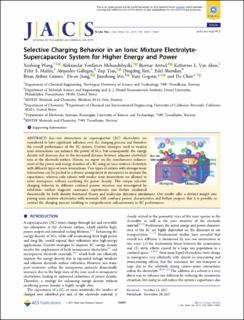| dc.contributor.author | Wang, Xuehang | |
| dc.contributor.author | Mehandzhiyski, Aleksandar Yordanov | |
| dc.contributor.author | Arstad, Bjørnar | |
| dc.contributor.author | Van Aken, Katherine L. | |
| dc.contributor.author | Tyler S., Mathis | |
| dc.contributor.author | Gallegos, Alejandro | |
| dc.contributor.author | Tian, Ziqi | |
| dc.contributor.author | Ren, Dingding | |
| dc.contributor.author | Sheridan, Edel | |
| dc.contributor.author | Grimes, Brian Arthur | |
| dc.contributor.author | Jiang, De-en | |
| dc.contributor.author | Wu, Jianzhong | |
| dc.contributor.author | Gogotsi, Yury | |
| dc.contributor.author | Chen, De | |
| dc.date.accessioned | 2020-12-22T12:49:42Z | |
| dc.date.available | 2020-12-22T12:49:42Z | |
| dc.date.created | 2018-01-19T12:23:57Z | |
| dc.date.issued | 2017 | |
| dc.identifier.citation | Journal of the American Chemical Society. 2017, 139 (51), 18681-18687. | en_US |
| dc.identifier.issn | 0002-7863 | |
| dc.identifier.uri | https://hdl.handle.net/11250/2720802 | |
| dc.description.abstract | Ion–ion interactions in supercapacitor (SC) electrolytes are considered to have significant influence over the charging process and therefore the overall performance of the SC system. Current strategies used to weaken ionic interactions can enhance the power of SCs, but consequently, the energy density will decrease due to the increased distance between adjacent electrolyte ions at the electrode surface. Herein, we report on the simultaneous enhancement of the power and energy densities of a SC using an ionic mixture electrolyte with different types of ionic interactions. Two types of cations with stronger ionic interactions can be packed in a denser arrangement in mesopores to increase the capacitance, whereas only cations with weaker ionic interactions are allowed to enter micropores without sacrificing the power density. This unique selective charging behavior in different confined porous structure was investigated by solid-state nuclear magnetic resonance experiments and further confirmed theoretically by both density functional theory and molecular dynamics simulations. Our results offer a distinct insight into pairing ionic mixture electrolytes with materials with confined porous characteristics and further propose that it is possible to control the charging process resulting in comprehensive enhancements in SC performance. | en_US |
| dc.language.iso | eng | en_US |
| dc.publisher | American Chemical Society | en_US |
| dc.relation.uri | http://pubs.acs.org/doi/10.1021/jacs.7b10693 | |
| dc.subject | Ions | en_US |
| dc.subject | Electrodes | en_US |
| dc.subject | Electrical properties | en_US |
| dc.subject | Electrolytes | en_US |
| dc.subject | Cations | en_US |
| dc.title | Selective Charging Behavior in an Ionic Mixture Electrolyte- Supercapacitor System for Higher Energy and Power | en_US |
| dc.type | Peer reviewed | en_US |
| dc.type | Journal article | en_US |
| dc.description.version | publishedVersion | en_US |
| dc.rights.holder | This is an open access article published under an ACS AuthorChoice License, which permits copying and redistribution of the article or any adaptations for non-commercial purposes. | en_US |
| dc.source.pagenumber | 18681-18687 | en_US |
| dc.source.volume | 139 | en_US |
| dc.source.journal | Journal of the American Chemical Society | en_US |
| dc.source.issue | 51 | en_US |
| dc.identifier.doi | 10.1021/jacs.7b10693 | |
| dc.identifier.cristin | 1547394 | |
| cristin.unitcode | 7401,80,3,3 | |
| cristin.unitcode | 7401,80,3,1 | |
| cristin.unitname | Sorbentbaserte teknologier | |
| cristin.unitname | Nye energiløsninger | |
| cristin.ispublished | true | |
| cristin.fulltext | original | |
| cristin.qualitycode | 2 | |
